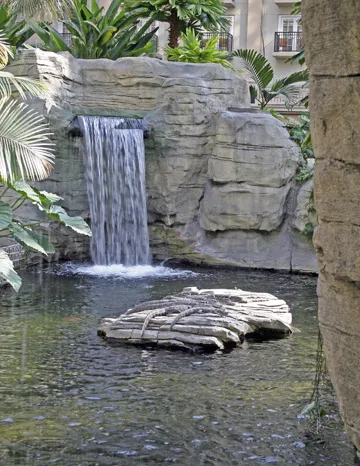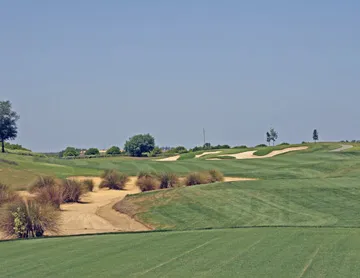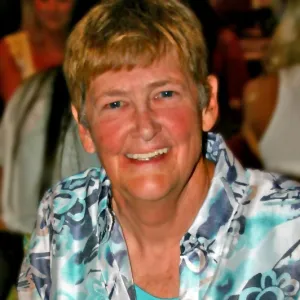Orlando: Golf Till You Drop
The Gaylord Palms Resort and Convention Center is a good place to begin an Orlando odyssey, especially after a winter hiatus when your home course is snowbound. The extraordinary Florida-themed hotel has 1,406 guestrooms ringing a 4 ½-acre glass-domed atrium. Many rooms have balconies overlooking the climate-controlled interior. Shops and restaurants are set among tropical gardens with waterfalls, streams, grottos and even an alligator lagoon.
Not far from the resort is the Falcon’s Fire Golf Club. The Rees Jones layout flows over the landscape like the sea on a balmy day, with mounds swelling on the perimeter and subsiding in gentle fairway rolls. There are several water carries (some with resident gators) to slick greens.
Follow golf with a massage in the resort’s Canyon Ranch Spa by specialists in golf muscles. From the spa, it’s a few steps to the Old Hickory Steakhouse, an Everglades-themed restaurant with sublime beef and buffalo steaks, an extensive wine list and flawless service.

Gaylord Palms inner courtyard. Copyright Donnelle Oxley
Bob Cupp, Jr. redesigned Joe Lee’s 1986 layout for the Hawk’s Landing Golf Club. Forming a horseshoe around the 2,000-room Orlando World Center Marriott and Convention Center, the 6,800-yard track runs through 200 acres of flowering foliage and tall grasses. Fairways dogleg frequently and are armed with deep bunkers. Water comes into consideration on all but three holes, and the entire back nine is riddled with it. It’s an intense but pleasurable gauntlet with a memorable flourish at the end. The eighteenth hole is a 565-yard, par 5 with a drive over water, a second shot threatened by sand and water, and a green positioned among mounds, palms and more water.
The Shingle Creek Golf Club is located on the fringe of the Orange County Convention Center complex, within earshot of the frenetic traffic artery, International Drive, and construction on the 1,500-room Rosen Shingle Creek Resort hotel, which is scheduled to open before year’s end. Last year, Golfweek included the course in its top 40 list of new venues.
The David Harman design gets a lot of traffic from convention attendees. It lends itself to speedy play, with spacious fairways and mounding that can bounce balls back into line if you don’t stray too far. The interconnecting waterways of Shingle Creek–once used to float cypress trees to a shingle-producing mill–are a threat on almost every hole.
Having played Royal Melbourne, I can see echoes of Australia’s famous Sandbelt layouts in the International Course at ChampionsGate. That’s no surprise, with Aussie Greg Norman at the drawing board. The 7,363-yard, links-style course is open and somewhat stark. Dune-like mounds rising to 40 feet provide views of fairways looping back and forth, with flags snapping in a brisk wind unobstructed by large trees. You almost expect to see golfers in plus fours pulling trolleys. The fairways are hard and fast and studded with 225 pot bunkers—conditions that would make any Aussie—or Brit–feel at home.

ChampionsGate Hole 7. Copyright Donnelle Oxley
The National Course is so different that it’s hard to believe the two came from the same designer and opened the same year, 2000. The National is a traditional American–style layout set in woods, wetlands and orange groves. Its springy fairways are shaded by mature trees, and its calculated greens are guarded by 100 rambling bunkers.
The golf complex includes the headquarters of the David Leadbetter Golf Academy and a multi-faceted golf clubhouse with an extensive pro shop, fine restaurant and 250-person function space. But the piece de resistance of the 1,500-acre, four-diamond resort is
the 750-room Omni Orlando at ChampionsGate. It’s a stunner, with spacious, elegantly appointed common areas; a 10,000-square-foot European spa; five unique restaurants; tennis, volleyball and basketball courts; a nine-hole par-three course; and a watersports park with a quiet pool, an active pool with waterslides, and an 850-foot-long lazy river.
Like ChampionsGate, the pros play a lot at Grande Lakes Orlando, a 500-acre resort with two hotels—the Ritz-Carlton and the JW Marriott. The Grande Lakes layout is also the work of Greg Norman, who tiptoed through the fragile ecosystem of cypress and native oaks on the front nine and used aggressive mounding on the back nine, which lay in a flood plain.
Caddies are de rigueur here. Ours told us that Tiger has said that Grande Lakes has the best greens in the state. They were stimping about 11 for us, so we had trouble keeping balls on the often small or shallow putting surfaces.
The course is tough, with lots of water and cagey bunkering. It’s also very natural. The layout borders the Everglades, so native plants and birds abound—along with a few alligators. Elevated wooden bridges wind through wetlands and trees draped with Spanish moss.
Like the International at ChampionsGate, the Grand Cypress Resort’s New Course is a horse of a different color. Picture a leopard-spotted Appaloosa running in the Kentucky Derby. In 1988, Jack Nicklaus paid homage to St. Andrews Old Course with a layout set in an open meadow among citrus groves. It’s all there—the double greens, the stone walls and bridges, the severe swales, the burn (creek) coiling like a snake around greens. The hidden pot bunkers are so deep (up to 12 feet) they have steps into them. There’s even wind sweeping across the open, virtually treeless expanse.
Having been on Scotland’s Old Course, I had fun identifying the features, but I confess that I’d rather play Florida-style courses in Florida. I love all the water and woods Nicklaus incorporated into the resort’s lush trio of nines–South, North and East. Lodging is in the Villas of Grand Cypress and the Hyatt Regency Grand Cypress.
The Reunion Resort & Club of Orlando, a frequent venue for LPGA and Legends tourneys, is a community with a savvy plan for fine living. A lot of dirt was moved to create the parkland Independence, Legacy and Tradition courses.
All have lofty tees and greens separated by chasms, wetlands and waste areas—and a Zen Garden feel, with flowering shrubs and flowers cascading over banks and rock gardens. Indigenous plants flourish in the wetland areas.
The more aggressive design is Tom Watson’s Independence Course, where rampant bunkering can punish even good shots. Craters of white sand and khaki-colored waste areas punctuate the kelly green fairways. The greens are huge and multi-tiered. Holes 11 through 17 border the Davenport Creek Preserve’s thicket of pine, live oak and cypress. Watson likes a mix of beauty, variety and strategy, and it’s all here—except water

Hole 17, Reunion’s Legacy Course. Copyright Donnelle Oxley
In contrast, Arnold Palmer’s Legacy Course is rife with lakes and streams. The designer doesn’t hold back on sand and waste bunkers, either, but he is forgiving, with frequent escape routes. Elevated tees and open fairways invite players to enjoy the view, pull out the driver and hit away.
Jack Nicklaus’ Tradition Course is a parkland style layout with elevated tees and greens and long sight lines. At first it seems benign, until you realize the crafty architect is trying to trick you into rick-reward shots that are heavy on risk.
There’s a high-rise hotel near the golf clubhouse, but it’s more fun to rent a villa or house in one of the resort’s diverse neighborhoods. All of the homes are artfully and comfortably furnished and have decks or balconies overlooking fairways or gardens.
The resort development is stunning in scope, with a spa and fitness center, pools, stables, a water park and a tennis complex, as well as miles of trails.
It’s impossible to discuss Orlando golf without including the Walt Disney World Resort, but it’s also nearly impossible to choose among the five 18-hole courses. PGA pros say the Palm Course is the toughest of the tournament venues, and have ranked the finishing hole as the fourth hardest on the PGA Tour. The Magnolia is the longest and arguably the prettiest, with more than 1,500 namesake trees and more wildlife than the other four. The Palm and Magnolia are Joe Lee designs with many elevated tees and greens. Eagle Pines, a low-lying venue with water defining the targets on 16 holes, is Pete Dye’s work. Tom Fazio crafted the hilly Osprey Ridge layout, a player-friendly track through wetlands frequented by the namesake birds. Lake Buena Vista, a timeless Joe Lee creation that opened in 1972, is being refurbished in 2014.
To learn about non-golf activities in Orlando, read Orlando: Magic Kingdom for Adults.
Tags:
About Dale

In the course of her life, she has exercised racehorses at New York's Belmont Park, shown jumping horses on the A Circuit, driven a race car with the late Paul Newman, and played the world's most famous golf courses. She is a former private pilot and an avid scuba diver. Read More...

In the course of her life, she has exercised racehorses at New York's Belmont Park, shown jumping horses on the A Circuit, driven a race car with the late Paul Newman, and played the world's most famous golf courses. She is a former private pilot and an avid scuba diver. Read More...
